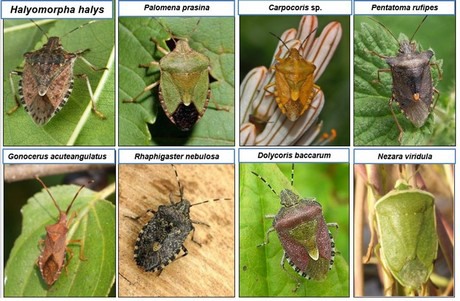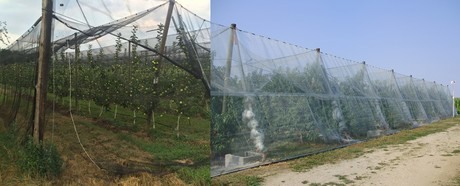H. halys compared to other bugs

In the Piedmont area, this insect has two generations a year and spends winter in sheltered environments such as houses, warehouses, etc. Due to this year's mild weather, it managed to survive even in the fields.
Once winter is over, adults develop in spontaneous host plants, then mating starts in winter and, towards mid/early May, females lay their eggs on the leaves. From mid June, the insects migrate to orchards (peach and pear trees to begin with, followed by apple and kiwi trees) as well as to cereal and vegetable crops and hazelnut groves. In the most serious cases, adults start laying their eggs also on the fruit.
Graziano Vittone, Agrion technical coordination manager, warns producers about the brown marmorated stink bug. "Now that the peach season is ending, you must monitor your apple orchards. Inspect the trees, especially the upper foliage, or shake them after placing a film underneath to count how many fall to the ground. These are both time-consuming operations, but they enable growers to assess the problem."
"You must intervene as soon as you notice the insect on the outer trees as, if it colonises the orchard, it will be too late and most of the produce will be damaged."
"In apple orchards, infestations can be avoided by using nets, checking the trees on the edge and with a good management of grassing."
The best nets are block or single-thread anti-hail ones with small holes (4x2 in the lower sections and 4x7 in the upper sections).

In all other cases, it must be stressed that bugs reach apple orchards from kiwi trees, peach orchards and cereal crops, so the edges must be constantly checked and protection barriers must be put in place.
Finally, grassing must be managed so as to prevent an excessive development and carrying out chemical treatments. If bugs have infested more than one area, treat the entire orchard (alternate rows should be enough) and reduce the time between treatments.
 Contacts:
Contacts:Graziano Vittone
Agrion -Fondazione per la ricerca l'innovazione e lo sviluppo tecnologico dell'agricoltura piemontese
Manta (CN)
Via Falicetto, 24
12030 Manta (CN)
Tel.: (+39) 0175 1953030
Email: [email protected]
Web: www.agrion.it










